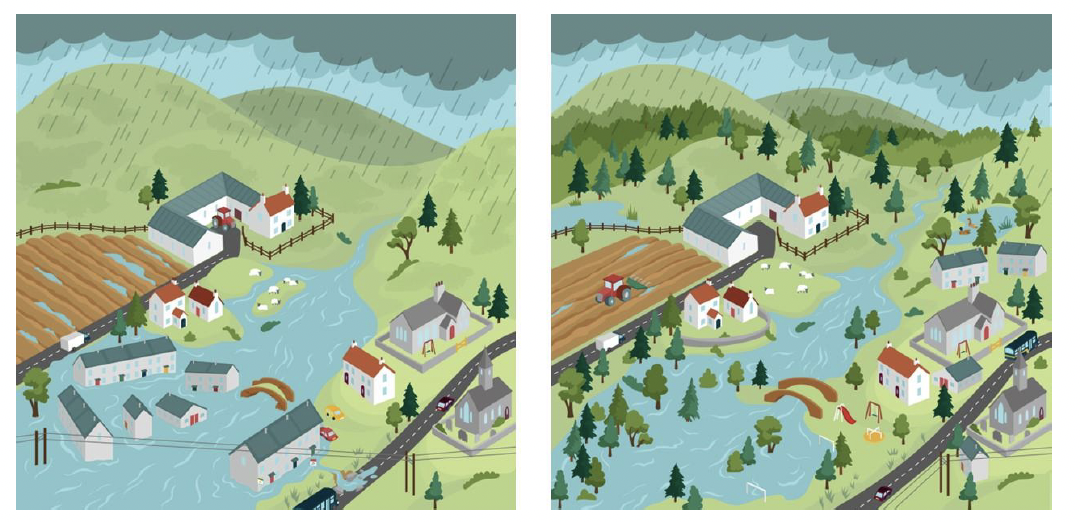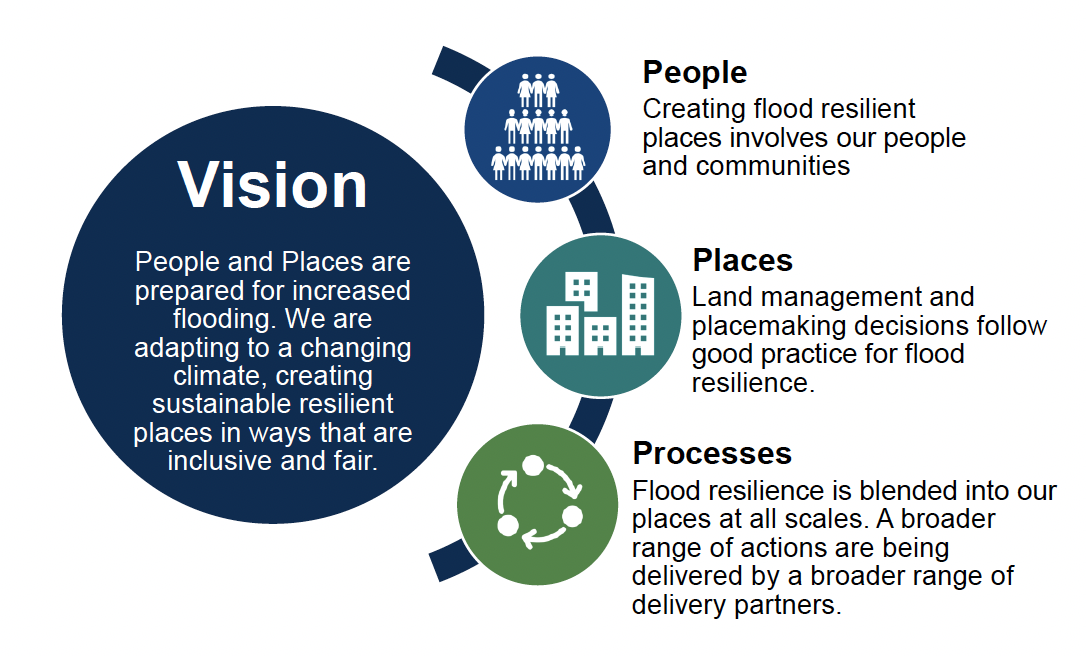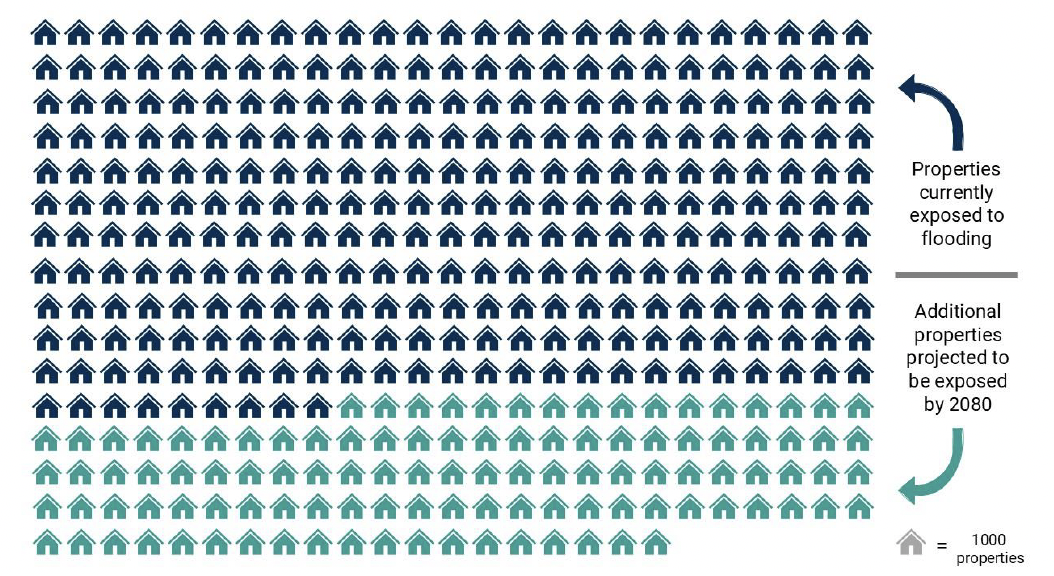National Flood Resilience Strategy
Sets out a vision for a flood resilient Scotland through to 2045 and beyond.
Introduction
The climate emergency is impacting on our communities, society, economic wellbeing, and the environment – both here at home and around the world.
Climate change means that Scotland will be warmer and wetter in winter, hotter and drier in summer, sea level rise will continue, and our weather will become more variable and unpredictable. Extreme events like Storm Babet last year, and the associated impacts that Brechin and other communities suffered as a result, will become more common.
Flooding is Scotland’s costliest climate hazard. We must adapt to our increasing flood exposure and respond to the impacts it is having on our people, places and activities. This is a challenge that Scotland must tackle together and ensure we are taking all available opportunities to overcome.
Tackling the impacts of climate change is one of our four top priorities for Scotland and creation of this strategy, as part of Scotland’s National Adaptation Plan and our wider Just Transition commitments, is a key element of our continued commitment to respond to the climate emergency.
The National Flood Resilience Strategy focuses on what Scotland needs to do to make our communities more flood resilient over the coming decades. It presents our flood resilience vision and the intended outcomes are structured around the themes of People, Place and Processes. It sets out the long-term policy direction and framework for improving flood resilience, our guiding principles and priority areas for action.
Delivering the Strategy will require multiple sectors working together to ensure that flood resilience is at the heart of the design of our places and our response to the changing climate.

Our Vision and Outcomes
Our vision and outcomes for a flood resilient Scotland through to 2045 and beyond:

Vision
People and Places are prepared for increased flooding. We are adapting to a changing climate, creating sustainable resilient places in ways that are inclusive and fair.
People
Creating flood resilient places involves our people and communities
Places
Land management and placemaking decisions follow good practice for flood resilience.
Processes
Flood resilience is blended into our places at all scales. A broader range of actions are being delivered by a broader range of delivery partners.
Strategy Purpose
Flood protection and flood risk management activity has been undertaken in Scotland for a number of years, with the current flood management framework being introduced in 2009. The climate emergency is significantly increasing the frequency and severity of flooding requiring us to review and refresh our response to ensure that we have an agreed national vision and approach to the challenges that brings. Focusing on building community flood resilience, the Strategy will increase the range and rate of delivery of actions both to manage our flood exposure, and to reduce the impacts of flooding when it does occur. Building on current delivery mechanisms, such as the existing flood risk management planning process,[1] it will enable new delivery opportunities and engage new delivery partners.
Scotland’s climate is changing and by 2100:
- Sea levels around the coast of Scotland are predicted to be at least 80cm higher and could be up to 1.90m higher;
- Peak rainfall intensities are expected to increase by up to 50%;
- Peak river flows are expected to increase by up to 60%.
As a result, our flood exposure is increasing. There are currently 284,000 properties across Scotland exposed to flooding, and by 2080 this number is expected to increase by 110,000 through climate change.

The 12 named storms of 2023/2024 have highlighted the significant and costly damage that flooding and coastal storm surges can have on our communities and infrastructure. We know that these impacts will become more frequent and more severe. We need to take action now to improve the resilience of our communities and ensure that we can continue to rely on our essential services as the climate changes.
The pace of response needs to match our increasing flood exposure
In recent years the flood protection scheme delivery programme has successfully provided protection for communities at a rate of between 400 and 800 properties per year. £570 million will be invested in flood resilience in the period 2016-2026. Since 2016, 16 flood protection schemes have been completed, 4 are under construction and a further 11 are in the early stages of development. However, each year 2,000 more properties are being exposed to flooding through climate change. We will need to ensure that we build on the progress to date and learn lessons of that delivery in order to increase the pace of delivery in future years.
The financial impact of flooding is increasing
The expected cost of flooding impacts in Scotland is now around £260 million per year[2]. This figure will continue to increase with inflation and as more properties and infrastructure become exposed to river, coastal and surface water flooding through climate change. To mitigate against the costs of damages caused by flooding, we will need to increase investment in flood resilience from all sectors to ensure our places are designed and prepared for the level of flooding we expect in future.
There has been a focus on a limited range of flood management actions
Most of Scotland’s flooding budget is currently spent on delivering large river and coastal flood protection schemes for towns and cities. This means that less is available for other measures such as surface water management, property flood resilience measures or nature-based actions and wider catchment management. It is clear that there is no simple solution to improving flood resilience that will work across all locations and for all communities. We need to better understand the relative benefit that a wider range of actions may deliver, and so help communities determine what may work best for them.
Flood actions are delivered through a limited range of contributors
Currently, almost all flood management actions are delivered through the Flood Risk Management Planning process and are carried out by flooding teams in local authorities, Scottish Water and SEPA supported by specialist engineering and technical consultants. This narrowly focuses the actions we are able to take to reduce our flood exposure and increase resilience. It also limits the opportunity to combine flood resilience activity with other activities to achieve multiple benefits for our places, communities and environment. In line with the Place Principle[3] there is a need to shift toward a plan-led, placed based approach where all the elements of design and development of our places have the potential to increase our flood resilience and achieve better outcomes for people and communities. There is a need to secure benefits across small interventions that manage surface water at a local scale right up to Local Development Plans that take account of and respond to flood risk at a strategic level, guiding development away from vulnerable areas. Making space for water and enabling places to adapt and respond.
The flooding challenge is increasing for future generations
The current approach to flooding, principally focused on flood protection, is increasing the challenge for future generations. As floods get bigger and happen more frequently, it will become more and more challenging to continue to provide protection for those who live in flood prone areas. For those communities most vulnerable to flooding, long-term adaptation planning is required to support communities through a resilience process that may include a slow transition away from those areas most exposed to flooding and coastal erosion where protection cannot be sustained in the long term.
Contact
Email: Flooding_Mailbox@gov.scot
There is a problem
Thanks for your feedback